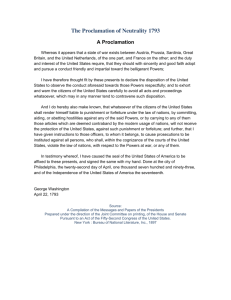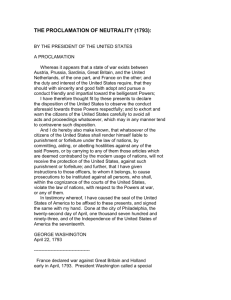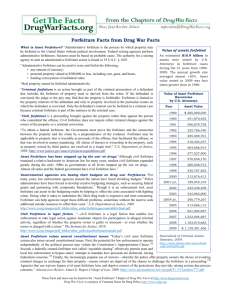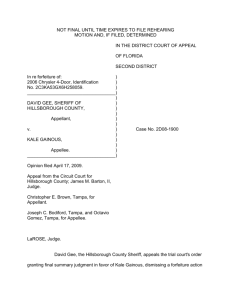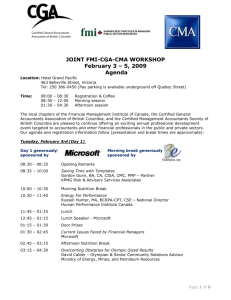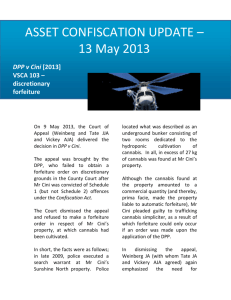Supreme Court of the United States
advertisement
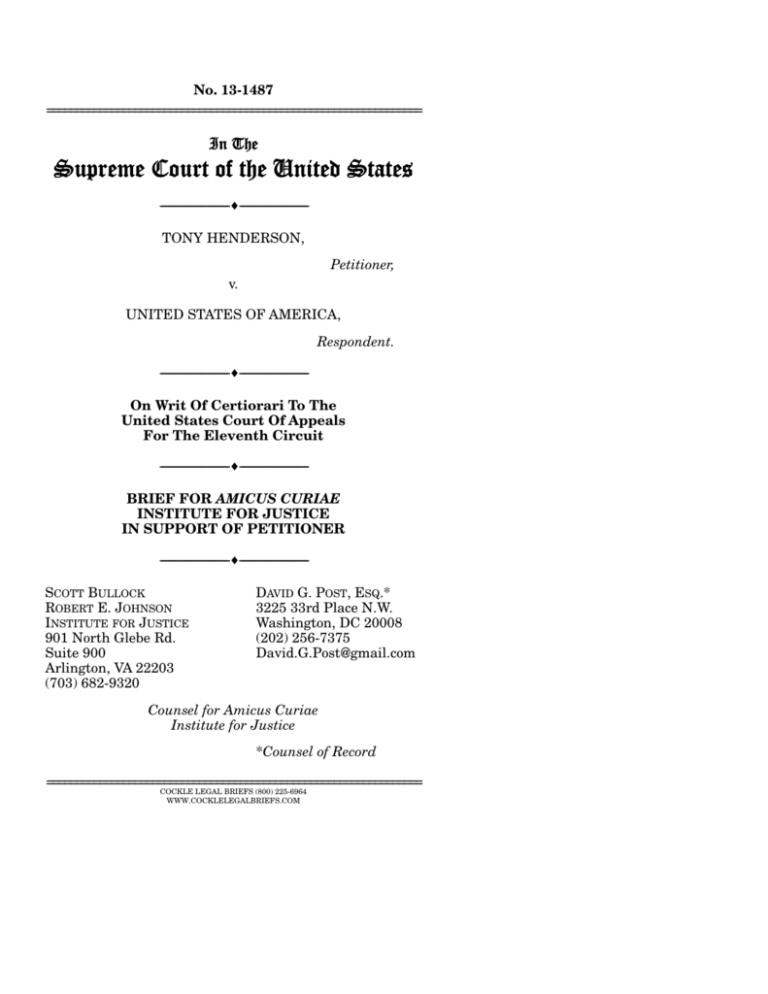
No. 13-1487 ================================================================ In The Supreme Court of the United States -----------------------------------------------------------------TONY HENDERSON, Petitioner, v. UNITED STATES OF AMERICA, Respondent. -----------------------------------------------------------------On Writ Of Certiorari To The United States Court Of Appeals For The Eleventh Circuit -----------------------------------------------------------------BRIEF FOR AMICUS CURIAE INSTITUTE FOR JUSTICE IN SUPPORT OF PETITIONER -----------------------------------------------------------------SCOTT BULLOCK ROBERT E. JOHNSON INSTITUTE FOR JUSTICE 901 North Glebe Rd. Suite 900 Arlington, VA 22203 (703) 682-9320 DAVID G. POST, ESQ.* 3225 33rd Place N.W. Washington, DC 20008 (202) 256-7375 David.G.Post@gmail.com Counsel for Amicus Curiae Institute for Justice *Counsel of Record ================================================================ COCKLE LEGAL BRIEFS (800) 225-6964 WWW.COCKLELEGALBRIEFS.COM i TABLE OF CONTENTS Page TABLE OF AUTHORITIES ................................... ii INTEREST OF AMICUS CURIAE ........................ 1 SUMMARY OF ARGUMENT ................................ 1 ARGUMENT ........................................................... 5 I. UNDER THE ONE FORD COACH CANON OF CONSTRUCTION, STATUTORY LANGUAGE MUST BE CONSTRUED TO AVOID FORFEITURES .............................. 5 II. THE DECISION BELOW TURNS THE ONE FORD COACH PRINCIPLE UPSIDE-DOWN........................................... 11 III. THE COURT SHOULD SEIZE THIS OPPORTUNITY TO REAFFIRM AND REINVIGORATE THE ONE FORD COACH PRINCIPLE ................................... 18 CONCLUSION ....................................................... 25 ii TABLE OF AUTHORITIES Page(s) CASES Cooper v. City of Greenwood, 904 F.2d 302 (5th Cir. 1990) .............................13, 14 Dobbins’s Distillery v. United States, 96 U.S. 395 (1878) .....................................................2 Farmers’ & Mechanics’ Nat’l Bank v. Dearing, 91 U.S. 29 (1875) .......................................................8 Harris v. United States, 215 F.2d 69 (4th Cir. 1954) .......................................9 Jacobson v. $55,900 in U.S. Currency, 728 N.W.2d 510 (Minn. 2007) .................................10 J.W. Goldsmith, Jr.-Grant Co. v. United States, 254 U.S. 505 (1921) ...................................................2 Lee v. City of Chicago, 330 F.3d 456 (7th Cir. 2003) ...................................10 Loretto v. Teleprompter Manhattan CATV Corp., 458 U.S. 419 (1982) ................................................. 11 Onwubiko v. United States, 969 F.2d 1392 (2d Cir. 1992) ...............................9, 18 Southview Assoc., Ltd. v. Bongartz, 980 F.2d 84 (2d Cir. 1992) ....................................... 11 State v. Fadness, 268 P.3d 17 (Mont. 2012) ..................................10, 14 United States v. 434 Main St., 961 F. Supp. 2d 298 (D. Mass. 2013) ........................9 iii TABLE OF AUTHORITIES – Continued Page(s) United States v. $38,000.00 in United States Currency, 816 F.2d 1538 (11th Cir. 1987) ..................................9 United States v. All Assets of Statewide Auto Parts, Inc., 971 F.2d 896 (2d Cir. 1992) .....................................18 United States v. Approximately 627 Firearms, 589 F. Supp. 2d 1129 (S.D. Iowa 2008) .............14, 17 United States v. Brown, 754 F. Supp. 2d 311 (D.N.H. 2010) ............. 15, 16, 17 United States v. Craft, 535 U.S. 274 (2002) .................................................12 United States v. Felici, 208 F.3d 667 (8th Cir. 2000) ...................................12 United States v. General Motors Corp., 323 U.S. 373 (1945) ................................................. 11 United States v. Giovanelli, 998 F.2d 116 (2d Cir. 1993) .......................................9 United States v. Henderson, 555 F. App’x 851 (11th Cir. 2014)............................12 United States v. Howell, 425 F.3d 971 (11th Cir. 2005) ..................................12 United States v. Miller, 588 F.3d 418 (7th Cir. 2009) ........... 10, 11, 13, 14, 17 United States v. Moore, 423 F. Supp. 858 (S.D. W.Va. 1976) ........................10 iv TABLE OF AUTHORITIES – Continued Page(s) United States v. One 1936 Model Ford V-8 De Luxe Coach, Commercial Credit Co., 307 U.S. 219 (1939) ......................................... passim United States v. One 1955 Ford 4-Door, 186 F. Supp. 547 (E.D. Tex. 1960) ......................9, 10 United States v. One 1976 Ford F-150 Pick-Up, 769 F.2d 525 (8th Cir. 1985) .....................................9 United States v. One 1980 Red Ferrari, 875 F.2d 186 (8th Cir. 1989) .....................................9 United States v. One Ford Coupe Auto., 272 U.S. 321 (1926) ...................................................2 United States v. Parsons, 472 F. Supp. 2d 1169 (N.D. Iowa 2007) ..................14 United States v. Premises Known as 608 Taylor Ave., 584 F.2d 1297 (3d Cir. 1978) ...................................10 United States v. Real Prop., 261 F.3d 65 (1st Cir. 2001) ........................................8 United States v. Rodriguez-Aguirre, 264 F.3d 1195 (10th Cir. 2001) ................................10 United States v. Zaleski, 686 F.3d 90 (2d Cir. 2012) .......................................14 Van Oster v. Kansas, 272 U.S. 465 (1926) ...................................................2 v TABLE OF AUTHORITIES – Continued Page(s) STATUTES & CODES Liquor Law Repeal and Enforcement Act of 1935, 49 Stat. 872, 878, codified at 27 U.S.C. § 40a ..........6 Comprehensive Crime Control Act of 1984, Pub. L. No. 98-473, 98 Stat. 1976 .......................3, 19 18 U.S.C. § 922(g) ............................................... passim 18 U.S.C. § 983(c) .........................................................9 18 U.S.C. § 3617(b)(3) ...................................................9 19 U.S.C. § 1616a(c) .....................................................3 21 U.S.C. § 881 .............................................................9 21 U.S.C. § 881(a)(4) .....................................................9 21 U.S.C. § 881(a)(6) .....................................................3 21 U.S.C. § 881(a)(7) .................................................3, 9 21 U.S.C. § 881(e)(1)(A) ................................................3 27 U.S.C. § 40a .............................................................6 28 U.S.C. § 524 .............................................................3 OTHER AUTHORITIES DAVID B. SMITH, PROSECUTION AND DEFENSE OF CIVIL FORFEITURE CASES (2014).............................2, 3 DICK M. CARPENTER II, LARRY SALZMAN & LISA KNEPPER, INEQUITABLE JUSTICE (Inst. for Justice 2011) .................................................................20 Eric Blumenson & Eva Nilsen, Policing for Profit: The Drug War’s Hidden Economic Agenda, 65 U. Chi. L. Rev. 35 (1998)........ 3, 4, 21, 22 vi TABLE OF AUTHORITIES – Continued Page(s) Eric Moores, Reforming the Civil Asset Forfeiture Reform Act, 51 Ariz. L. Rev. 777 (2009) ..........21 Jeff Brazil & Steve Berry, Tainted Cash or Easy Money?, Orlando Sentinel, June 14, 1992 .........................................................................24 Jennifer Emily, Audit of Dallas County DA’s Forfeiture Fund Provides Few Clear Answers, Dallas Morning News, Nov. 7, 2014 .......................23 John Burnett, Sheriff Under Scrutiny over Drug Money Spending, NPR, June 18, 2008 ...................23 John Emshwiller, Gary Fields & Jennifer Levitz, Motel Is Latest Stopover in Federal Forfeiture Battle, Wall St. J., Oct. 18, 2011............23 John Yoder and Brad Cates, Op-Ed: Government Self-Interest Corrupted A Crime-Fighting Tool Into An Evil, Washington Post, Sept. 18, 2014 ...........................................................................4 Laura Krantz, Audit: Worcester DA’s Office Bought Zamboni, Lawn Gear with Forfeited Drug Money, MetroWest Daily News, Feb. 15, 2013 .............................................................23, 24 Margaret H. Lemos & Max Minzner, For-Profit Public Enforcement, 127 Harv. L. Rev. 853 (2014) ...................................................................3, 21 MARIAN R. WILLIAMS ET AL., POLICING FOR PROFIT (2010) ............................................. 3, 4, 19, 20 vii TABLE OF AUTHORITIES – Continued Page(s) Michael Sallah, Robert O’Harrow Jr. & Steven Rich, Stop and Seize: Aggressive Police Take Hundreds of Millions of Dollars from Motorists Not Charged With Crimes, Washington Post, Sept. 6, 2014 ....................................... 19, 20, 23 Mike Moore & Jim Hood, The Challenge to States Posed by Federal Adoptive Forfeitures, National Ass’n of Att’ys Gen. Civil Remedies in Drug Enforcement Report, June-July 1992.......22 Nkechi Taifa, Civil Forfeiture vs. Civil Liberties, 39 N.Y.L. Sch. L. Rev. 95 (1994) ......................21 Rand Paul, The Government Can Seize Your Property in Violation of the 5th Amendment, Breitbart, Oct. 28, 2014 ..........................................20 Rep. Tim Walberg, Op-Ed: Stopping the Abuse of Civil Forfeiture, Washington Post, Sept. 4, 2014 ............................................................... 4, 19, 20 Sarah Stillman, Taken: Under Civil Forfeiture, Americans Who Haven’t Been Charged With Wrongdoing Can Be Stripped of Their Cash, Cars, and Even Homes, New Yorker, Aug. 12, 2013 ............................................................. 19, 20, 23 Shaila DeWan, Law Lets I.R.S. Seize Accounts on Suspicion, No Crime Required, N.Y. Times, Oct. 25, 2014................................................23 Shaila DeWan, Police Use Department Wish List When Deciding Which Assets to Seize, N.Y. Times, Nov. 9, 2014 ...................................21, 23 viii TABLE OF AUTHORITIES – Continued Page(s) U.S. DEP’T OF JUSTICE, AFF AND SEIZED ASSET DEPOSIT FUND ANNUAL FINANCIAL STATEMENT FISCAL YEAR 2001 ....................................................19 U.S. DEP’T OF JUSTICE, AFF AND SEIZED ASSET DEPOSIT FUND ANNUAL FINANCIAL STATEMENTS FISCAL YEAR 2013 ....................................................19 U.S. DEP’T OF JUSTICE, FY 2013 ASSET FORFEITURE FUND REPORTS: TOTAL NET DEPOSITS TO THE FUND BY STATE OF DEPOSIT ...........................3, 19 U.S. DEP’T OF JUSTICE, SELECTED FEDERAL ASSET FORFEITURE STATUTES (2006) ............................24 Zeke McCormack, Former District Attorney Sentenced in Kerrville, San Antonio ExpressNews, May 22, 2010 ................................................23 1 INTEREST OF AMICUS CURIAE1 The Institute for Justice is a nonprofit, public interest law firm committed to defending the essential foundations of a free society by securing greater protection for individual liberty and by restoring constitutional limits on the power of government. The Institute litigates civil forfeiture cases nationwide, in order to combat the use of the civil forfeiture laws to seize property without respect for due process of law. The Institute is filing this amicus brief in support of Petitioner because this case offers an important opportunity for the Court to address prosecutors’ aggressive application of the forfeiture laws and the expansive interpretation of those laws adopted by the courts. ------------------------------------------------------------------ SUMMARY OF ARGUMENT Nearly eighty years ago, in words that retain their relevance today, this Court observed that the “forfeiture acts are exceedingly drastic.” United States v. One 1936 Model Ford V-8 De Luxe Coach, Commercial Credit Co., 307 U.S. 219, 236 (1939) (“One Ford Coach”). In light of that concern, the Court articulated a simple but powerful principle of statutory 1 All parties have consented to the filing of this brief. Amicus affirms that no counsel for any party authored this brief in whole or in part and that no person or entity made a monetary contribution specifically for the preparation or submission of this brief. 2 construction: “Forfeitures are not favored; they should be enforced only when within both letter and spirit of the law.” Id. at 226. The decision below contravenes that canon of construction. Faced with alternate interpretations of the felon-in-possession law, the Eleventh Circuit chose the interpretation that produces a de facto forfeiture – while disregarding reasonable interpretations that avoid that result. On that basis alone, the decision below should be reversed. The One Ford Coach canon of construction is not only controlling in this case, but also resonates within the case’s broader context. The Court decided One Ford Coach against the backdrop of the first great wave of forfeiture proceedings in the United States, arising out of Prohibition and its immediate aftermath.2 As “drastic” as the forfeiture laws may have appeared at that time, however, the laws of that era appear quaint in comparison to the forfeiture laws today. We are, at present, roughly thirty years into a second great wave of forfeiture proceedings, associated, this time, not with alcohol but with the government’s “War on Drugs.”3 2 See, e.g., J.W. Goldsmith, Jr.-Grant Co. v. United States, 254 U.S. 505 (1921); United States v. One Ford Coupe Auto., 272 U.S. 321 (1926); Van Oster v. Kansas, 272 U.S. 465 (1926); cf. Dobbins’s Distillery v. United States, 96 U.S. 395 (1878) (early forfeiture case involving taxation of alcohol). 3 See generally DAVID B. SMITH, PROSECUTION AND DEFENSE OF CIVIL FORFEITURE CASES § 1.01 (2014) (tracing the development (Continued on following page) 3 The unprecedented scope of the forfeiture laws in our present era can be glimpsed in a single statistic: In 1986, the year the Department of Justice’s Assets Forfeiture Fund was created, the fund took in just $93.7 million in deposits. By 2013, that figure had 4 swollen to more than $2 billion. Federal law allows of the forfeiture laws from “harsh and effective laws to deter smuggling and other attempts to evade payment of customs duties and excise taxes” to “a new era when forfeitures would become an integral part of modern law enforcement”); Margaret H. Lemos & Max Minzner, For-Profit Public Enforcement, 127 Harv. L. Rev. 853, 868-69 (2014) (describing “long historical pedigree” of forfeiture in the U.S. and noting recent connection to government’s anti-drug-trafficking enforcement activities); Eric Blumenson & Eva Nilsen, Policing for Profit: The Drug War’s Hidden Economic Agenda, 65 U. Chi. L. Rev. 35, 42-45 (1998) (same). See also sources cited in Part III infra. Most commentators point to the Comprehensive Crime Control Act of 1984, Pub. L. No. 98-473, 98 Stat. 1976 as the start of the recent wave of forfeiture activity. See SMITH, supra, at 1-5; see also Blumenson & Nilsen, supra, at 44-45. Three features of that statute are responsible, in large measure, for this expansion: (a) it authorized, for the first time, the forfeiture of property used (or intended to be used) to “facilitate” a drug offense, see 21 U.S.C. § 881(a)(6) & (7); (b) it allowed federal law enforcement agencies to retain and use the proceeds from forfeitures, instead of requiring that they be deposited in the Treasury’s General Fund, see 28 U.S.C. § 524; and (c) it initiated the federal “Equitable Sharing Program,” which gives state and local police agencies the lion’s share of seized assets even when federal agents were involved in the arrest, see 21 U.S.C. § 881(e)(1)(A) and 19 U.S.C. § 1616a(c). 4 Compare MARIAN R. WILLIAMS ET AL., POLICING FOR PROFIT 31 (2010), available at http://www.ij.org/images/pdf_folder/other_ pubs/assetforfeituretoemail.pdf., with U.S. DEP’T OF JUSTICE, FY 2013 ASSET FORFEITURE FUND REPORTS: TOTAL NET DEPOSITS TO (Continued on following page) 4 the Department of Justice to retain proceeds from forfeitures in the Assets Forfeiture Fund, and to use those proceeds to fund law enforcement agencies.5 Commentators have decried the growth of forfeiture, explaining that the forfeiture laws “are producing self-financing, unaccountable law enforcement agencies divorced from any meaningful legislative 6 oversight.” Indeed, two former Department of Justice officials involved in the creation of the current forfeiture regime recently opined that forfeiture “has turned into an evil itself, with the corruption it engendered among government and law enforcement coming to clearly outweigh any benefits.”7 The instant case offers the Court an opportunity to take a small but important step to curb what has become a veritable nationwide forfeiture epidemic.8 The Eleventh Circuit’s strained and unnecessarily broad reading of the felon-in-possession statute – stretching a statutory provision prohibiting “possess[ion]” of FUND BY STATE OF DEPOSIT, available at http://www.justice. gov/jmd/afp/02fundreport/2013affr/report1.htm; see also Rep. Tim Walberg, Op-Ed: Stopping the Abuse of Civil Forfeiture, Washington Post, Sept. 4, 2014. 5 See WILLIAMS, supra note 4; see also U.S. Dep’t of Justice, The Fund, at http://www.justice.gov/jmd/afp/02fundreport/02_2.html. 6 Blumenson & Nilsen, supra note 3, at 41. 7 John Yoder and Brad Cates, Op-Ed: Government SelfInterest Corrupted A Crime-Fighting Tool Into An Evil, Washington Post, Sept. 18, 2014. 8 See Part III infra. THE 5 firearms, 18 U.S.C. § 922(g), to cover any transfer of ownership of those firearms – works in practical effect a complete forfeiture of Mr. Henderson’s property interest in his firearm collection. By adopting the one construction of the statute that produces forfeiture, absent any indication in the statute itself (or elsewhere) that Congress intended such a result, while rejecting reasonable alternative construction(s) that would not involve imposition of this “exceedingly drastic” remedy, One Ford Coach, 307 U.S. at 236, the Eleventh Circuit has turned the One Ford Coach principle completely on its head. We urge the Court to reaffirm the One Ford Coach principle and to apply it here, reversing the Eleventh Circuit judgment while reminding lower courts of their duty to find reasonable ways to avoid imposing this particular remedy unless specifically and expressly directed to do so by Congress. ------------------------------------------------------------------ ARGUMENT I. Under the One Ford Coach Canon of Construction, Statutory Language Must Be Construed to Avoid Forfeitures. In United States v. One 1936 Model Ford V-8 De Luxe Coach, Commercial Credit Co., 307 U.S. 219 (1939) (“One Ford Coach”), this Court articulated a straightforward canon of construction to apply where (as here) one alternate interpretation of a law would result in a forfeiture: the law should be interpreted to 6 avoid forfeiture wherever such an interpretation is reasonable. The Court in One Ford Coach had to interpret the Liquor Law Repeal and Enforcement Act of 1935, 49 Stat. 872, 878, codified at 27 U.S.C. § 40a, which authorized forfeiture of automobiles used for “unlawful transportation of distilled spirits upon which the federal tax had not been paid.” The law subjected purchasers of used cars to what has been called “Bootlegger Risk”: the possibility that the automobiles they purchased could be seized and forfeited to the government as a result of activities undertaken by prior owners years before. To partially mitigate that risk, the Act allowed courts to remit forfeitures, and to restore title to the purchaser, if the purchaser could show that he or she had acted “in good faith.” If, however, “it appear[ed]” that the purchaser’s interest had been acquired from a person having a “record or reputation” for violating the liquor laws, the purchaser had to show that he or she (a) made an inquiry with law enforcement agencies as to “the character or financial standing” of that person, and (b) had been informed “in answer to his inquiry” that the person in question “had no such record or reputation.” Id. at 222. One Ford Coach called for application of this statutory scheme to somewhat unusual facts. The party seeking remittance of the forfeiture was an automobile finance company that had been assigned a sales contract for a vehicle sold to one “Paul Walker.” Before accepting the assignment, the finance company 7 had inquired about Walker’s character and financial standing with local law enforcement agencies and had been informed that his record was clean. Id. at 222-23. Unbeknownst to the finance company, however, Paul Walker was merely a “straw purchaser” of the vehicle, acting on behalf of the “real purchaser” – his brother, Guy Walker. Id. at 224. The finance company, unaware of the arrangement between the brothers, had made “no inquiry or investigation whatsoever,” id. at 223, concerning Guy Walker; had they done so, they would have been informed that Guy Walker did indeed have a “previous record and reputation for violating both state and federal laws relating to liquor.” Id. at 222. The government argued that the forfeiture could not be remitted because the finance company had “made no adequate inquiry concerning the record and reputation of the real purchaser – Guy Walker,” id. at 224, and the Court acknowledged that the statute, if “taken literally,” id. at 235, supported that result. The Court stated that the literal terms of the statute “inhibit remission by the court unless one who claims an interest made actual inquiry concerning every person with record or reputation for violating the liquor laws who in fact . . . had acquired some right to the vehicle,” and “[t]hus construed[,] the provision would require absolute forfeiture notwithstanding the claimant could not by the utmost diligence ascertain the true situation.” Id. But the Court refused to adopt that “literal[ ]” reading of the statute, instead articulating and then 8 applying a simple but powerful principle of statutory construction: “Forfeitures are not favored; they should be enforced only when within both letter and spirit of the law.” Id. at 226 (emphasis added) (citing Farmers’ & Mechanics’ Nat’l Bank v. Dearing, 91 U.S. 29, 33-35 (1875) (“Courts always incline against [forfeitures]. When either of two constructions can be given to a statute, and one of them involves a forfeiture, the other is to be preferred.”) (emphasis added) (citations omitted). It is not sufficient, the Court held, that the statutory provision in question “permit[s],” id. at 225, the construction urged by the government. Only where the intent to require forfeiture has been “expressed in language sufficiently plain to admit no reasonable doubt” should the statute be read as “requiring absolute forfeiture under such circumstances.” Id. at 235. Finding no such plain statement, the Court ordered the forfeiture remitted. The One Ford Coach principle, or canon, of statutory interpretation – directing courts to construe statutes narrowly so as to avoid forfeitures unless commanded by the “letter and spirit of the law,” id. at 226, expressed in “unclouded language,” id. at 236, that is “sufficiently plain to admit no reasonable doubt,” id. at 235 – has great continuing vitality, as attested by the long list of lower court decisions that have relied upon it.9 It underlies and helps to explain 9 See, e.g., United States v. Real Prop., 261 F.3d 65, 74 (1st Cir. 2001) (“mindful of the well established rule that federal forfeiture statutes must be narrowly construed because of their (Continued on following page) 9 potentially draconian effect,” court holds that claimant satisfies requirements of the “innocent owner defense” and dismisses forfeiture action under 21 U.S.C. § 881(a)(7)); United States v. Giovanelli, 998 F.2d 116, 119 (2d Cir. 1993) (citing One Ford Coach and explaining that, while the forfeiture statutes give the Government “vast and important powers,” those powers “must be exercised in the precise manner the statutes provide”); Onwubiko v. United States, 969 F.2d 1392, 1400 (2d Cir. 1992) (narrowly construing the “facilitation” requirement for drugrelated-offense seizure under 21 U.S.C. § 881 to reverse denial of motion to return claimant’s property, quoting One Ford Coach and noting that “[d]espite this fifty-odd-year-old command, forfeitures are becoming more frequent in number and more summary in nature”); United States v. One 1980 Red Ferrari, 875 F.2d 186, 188 (8th Cir. 1989) (citing One Ford Coach, noting that “forfeitures are not favored,” and finding in the “sparse legislative history of 21 U.S.C. § 881” indication that “the federal forfeiture statute is to be strictly construed”); United States v. $38,000.00 in United States Currency, 816 F.2d 1538, 1547 (11th Cir. 1987) (citing One Ford Coach and placing “heavier” burden on the government than on claimants “to adhere to the procedural rules” governing forfeiture because “strict compliance with the letter of the law by those seeking forfeiture must be required”); United States v. One 1976 Ford F-150 Pick-Up, 769 F.2d 525, 527 (8th Cir. 1985) (invoking One Ford Coach principle to find that claimant’s truck was not “ ‘substantially associated’ ” with drug offense to support forfeiture under 21 U.S.C. § 881(a)(4)); Harris v. United States, 215 F.2d 69, 72-73 (4th Cir. 1954) (reversing denial of claimant’s motion to remit forfeiture under 18 U.S.C. § 3617(b)(3), finding “grounds to sustain a more lenient interpretation of the Act” based on One Ford Coach principle that statute “should be liberally interpreted in favor of remission”); United States v. 434 Main St., 961 F. Supp. 2d 298, 319 (D. Mass. 2013) (narrowly construing the “substantial connection between the property and the offense” required for forfeiture under the Civil Asset Forfeiture Reform Act of 2000, 18 U.S.C. § 983(c), to remit forfeiture of claimant’s motel; alternate reading of statute “would be inconsistent with ‘both letter and spirit of the law’ ” (quoting One Ford Coach)); United States v. (Continued on following page) 10 courts’ hostility to de facto forfeitures – i.e., measures achieving the “functional equivalent of forfeiture,” United States v. Miller, 588 F.3d 418, 419 (7th Cir. 2009), without having to satisfy any of the constitutional and statutory safeguards applicable to forfeiture proceedings. See Lee v. City of Chicago, 330 F.3d 456, 466 (7th Cir. 2003) (“due-process guarantees” prevent government from using its “authority to seize [to] effect de facto forfeitures of property by retaining items indefinitely”) (citing United States v. Premises Known as 608 Taylor Ave., 584 F.2d 1297 (3d Cir. 1978)); id. at 1302 (noting “possible constitutional underpinnings” of rules against de facto forfeitures) (citing United States v. Moore, 423 F. Supp. 858 (S.D. W.Va. 1976)); State v. Fadness, 268 P.3d 17, 23 (Mont. 2012) (while it is “well settled that the government may seize evidence for use in investigations and trial,” it may not, “by exercising its power to seize, effect a de facto forfeiture by retaining the seized property indefinitely”) (citing United States v. Rodriguez-Aguirre, 264 F.3d 1195, 1212 (10th Cir. 2001)). And, as explored in greater detail in the One 1955 Ford 4-Door, 186 F. Supp. 547, 551 (E.D. Tex. 1960) (narrowly construing the “record” requirement of forfeiture statute on grounds that statute “should be construed liberally in favor of relieving from the drastic effects of the forfeiture acts those who act in good faith and without negligence” (quoting One Ford Coach)); Jacobson v. $55,900 in U.S. Currency, 728 N.W.2d 510, 521 (Minn. 2007) (construing state forfeiture statute in accordance with One Ford Coach principle so as to “strictly construe its language and resolve any doubt in favor of the party challenging it”). 11 following section, it has an obvious and important application to the instant case. II. The Decision Below Turns The One Ford Coach Principle Upside-Down. The decision below flouts the One Ford Coach principle by straining to construe § 922(g) to effect a de facto forfeiture of Mr. Henderson’s ownership interest in his firearm collection – notwithstanding the availability of reasonable, alternate statutory interpretations that would avoid forfeiture. The decision below has worked the “functional equivalent of forfeiture,” Miller, 588 F.3d at 419, in regard to Mr. Henderson’s ownership interest in his gun collection. “Property rights in a physical thing have been described as the rights ‘to possess, use and dispose of it.’ ” Loretto v. Teleprompter Manhattan CATV Corp., 458 U.S. 419, 435 (1982) (citing United States v. General Motors Corp., 323 U.S. 373, 377-78 (1945)); see also id. (“the group of rights inhering in the citizen’s relation to the physical thing, as the right to possess, use and dispose of it . . . we denominate ownership”); Southview Assoc., Ltd. v. Bongartz, 980 F.2d 84, 93 (2d Cir. 1992) (adopting Loretto formulation that a taking has occurred “when government action permanently destroys the three rights associated with the ownership of property: the power to possess, to use, and to dispose”). In holding that § 922(g) renders a court powerless to “grant[ ] Mr. Henderson actual or constructive possession of a 12 firearm,” United States v. Henderson, 555 F. App’x 851, 853 (11th Cir. 2014), and that transfer of ownership of the property to a third party would necessarily require him to take “constructive possession” of it,10 the court eliminated the last of the rights remaining in Henderson’s “bundle of sticks,” United States v. Craft, 535 U.S. 274, 278 (2002). Henceforth, he can neither possess, use, nor dispose of what had previously been his property. The Eleventh Circuit’s disposition would, perhaps, be defensible if the statutory provision in question were susceptible to no other reasonable reading than the one it adopted. But as decisions by three other Courts of Appeals, one State Supreme Court, and several lower courts have made clear, that is most emphatically not the case. 10 The court below provided virtually no discussion to explain or justify its conclusion that Mr. Henderson’s request for a court-ordered transfer of the property to a third party would require giving him “constructive possession” of it, relying instead on its earlier decision in United States v. Howell, 425 F.3d 971 (11th Cir. 2005), which it viewed as controlling. In Howell, the court denied a convicted felon’s Rule 41(g) motion asking the court either to return seized firearms to him or, in the alternative, to “place the firearms in the possession of a relative in trust or sell the firearms and distribute the proceeds to him.” Id. at 977. Describing the latter request as “interesting,” the court in Howell nonetheless agreed with the Eighth Circuit that because such action “suggests constructive possession,” id. at 976-77 (quoting United States v. Felici, 208 F.3d 667, 670 (8th Cir. 2000)), and because “[a]ny firearm possession, actual or constructive, by a convicted felon is prohibited by law,” id., it could not grant the request. 13 For instance, in United States v. Miller, 588 F.3d 418, 419-20 (7th Cir. 2009), the court, relying on Cooper v. City of Greenwood, 904 F.2d 302 (5th Cir. 1990), held that § 922(g) does not prohibit a court from ordering the transfer of a convicted felon’s ownership interest in firearms to a third party, because such transfers need not involve “possession” of the property, actual or constructive, by the transferor. In Miller, the government had sought forfeiture of firearms that had been seized at defendant’s residence, but it had missed the statutory deadline for doing so. Miller, 588 F.3d at 418-19. Miller then asked the court to sell the weapons for his account, or alternatively to “deliver them to someone legally entitled to possess them.” Id. at 419. The government asserted that because § 922(g)’s prohibition against “possession” included “constructive possession” of the firearms, it prohibited both of Miller’s proposed courses of action. Id. The court disagreed. While “surrender[ing] the firearms to someone willing to accept Miller’s instructions about their disposition” would indeed amount to granting Miller constructive possession of the firearms, id., the court observed that “there are other possibilities” including “having a trustee sell or hold the guns, or giving them to someone who can be relied on to treat them as his own.” Id. at 419-20. Because the property had not been the subject of a true forfeiture proceeding, the Seventh Circuit held that Miller’s property interest in the firearms “continues even though his possessory interest has been 14 curtailed,” id. at 420; the government therefore “must offer Miller some . . . lawful option” for disposal of that property interest. Id.11 11 See also United States v. Zaleski, 686 F.3d 90, 93 (2d Cir. 2012) (holding that “a convicted felon may arrange to benefit from the sale of otherwise lawful, unforfeited firearms by a third party without actually or constructively possessing them” and therefore may validly transfer his ownership interest in firearms through a Rule 41(g) motion) (emphasis added); Cooper v. City of Greenwood, 904 F.2d 302, 305-06 (5th Cir. 1990) (convicted felon retains a “constitutionally protected” non-possessory ownership interest in surrendered firearms; rejecting government’s argument that § 922(g) renders forfeiture proceeding “an empty and needless formality” if government seeks to divest claimant of that non-possessory interest); United States v. Approximately 627 Firearms, 589 F. Supp. 2d 1129, 1139-40 (S.D. Iowa 2008) (holding that § 922(g) does not prohibit court from “ordering the sale of [claimant’s] personal firearms and the distribution of the proceeds to him,” because that “would not result in [claimant’s] exercise of ‘dominion’ and/or ‘control’ over the property” but would instead simply “restore [him], as closely as possible under the circumstances, to the same position he would have been in had the Government not seized his personal firearms to begin with”); United States v. Parsons, 472 F. Supp. 2d 1169, 1175 (N.D. Iowa 2007) (“Because the government already had taken possession and control over the firearms, and in doing so has also already deprived defendant Parsons of nearly all vestiges of ownership, the court concludes that permitting defendant Parsons to now designate to whom his firearm collection should be given does not rise to the level of constructive possession but is, instead, permitting defendant Parsons to exercise only the merest indicia of ownership.”) (emphasis added); State v. Fadness, 268 P.3d 17, 20, 29-30 (Mont. 2012) (court may, consistent with Section 922(g), transfer convicted felon’s firearms to a third party or to have the State sell firearms for the benefit of their owner). 15 United States v. Brown, 754 F. Supp. 2d 311 (D.N.H. 2010), is also illustrative of the manner in which courts have given a reasonable reading of § 922(g)’s prohibition against “possession” of firearms without causing de facto forfeiture of the claimant’s property. Brown, a defendant in a criminal tax-fraud and money-laundering case, had voluntarily surrendered firearms that he owned as a condition of his release on bail. Id. at 313. Subsequent to his conviction, he signed and delivered a document purporting to transfer the firearms to a third party, Bernhard 12 Bastian. When the government subsequently sought forfeiture of the weapons, Bastian opposed the action on the grounds that they had been lawfully transferred to him by Brown. The government countered that “a convicted felon cannot lawfully divest himself of mere legal title to firearms that he can no longer lawfully possess, without thereby ‘constructively possessing’ those firearms.” Id. at 314-15.13 12 The document read, in relevant part: [I]n the event of my death or incarceration or in any circumstances which prohibit my repossessing my property (guns, ammunition, firearms or any other items held at Riley’s Sport Shop, Inc., at 1575 Hooksett Road, Hooksett, New Hampshire) all that property in its entirety is to be given to Bernhard Bastian, Weare, New Hampshire. Brown, 754 F. Supp. 2d at 313. 13 As the court summarized the government’s view: [B]ecause Brown became a convicted felon upon return of the jury’s guilty verdicts . . . he could not then, (Continued on following page) 16 In the court’s view, this amounted to declaring that “[a] person who lawfully owns, say, a valuable gun collection just before a jury returns an unrelated felony guilty verdict (e.g., for mail fraud) can, thereafter, no longer sell, give away, or transfer legal title to that collection.” Id. at 315 (emphasis added). Such a rule would “stretch the concept of ‘constructive possession,’ as the term is used in [§ 922(g)], much too far . . . essentially equating criminal constructive possession with even the most minimal exercise of an indicia of ownership – transferring legal title.” Id. Neither the language of the statute, nor the cases relied upon by the government, required such a construction: [S]trictly speaking, the decisions relied upon by the government are not so clear – they do generally accept that a defendant in such a predicament cannot unilaterally direct or “dictate” the specific disposition of owned or at any time thereafter, actually or constructively possess the firearms . . . (i.e., he could not exercise “dominion or control” over them). Therefore, the government concludes, Brown also could no longer divest himself of legal title to the firearms, because the minimal act of transferring title, even to property in the government’s exclusive possession, necessarily requires the exercise of some “dominion or control,” which, in turn, would constitute the crime of unlawful “possession,” prohibited by [§ 922(g)]. . . . [T]o the extent [Brown’s] letter purports to transfer title [to Bastian], it is void. Id. (emphasis added). 17 firearms, but they do not, for example, hold that title to the firearms cannot be conveyed, or that a court cannot order an appropriate disposition of such firearms, for the benefit of the defendant. Id. at 315. The court declined to adopt the government’s interpretation, preferring instead a “pragmatic solution” according to which “the court, exercising equitable powers, may order the transfer of title . . . for the felon-owner’s benefit.” Id. at 317 (citing United States v. Approximately 627 Firearms, 589 F. Supp. 2d 1129, 1140 (S.D. Iowa 2008)). The court explained that this approach “avoids serious constitutional issues” and “fully protects the felon-owner’s legitimate property interests.” Id. As Miller, Brown, and the other cases cited in note 11 make clear, the One Ford Coach interpretive canon – “When either of two constructions can be given to a statute, and one of them involves a forfeiture, the other is to be preferred” – is not simply empty phraseology; it directs courts to look for “pragmatic solutions” to statutory construction problems that avoid imposing forfeiture or forfeiture-like remedies where Congress has not expressly provided for them. In the instant case, the Eleventh Circuit got it completely backwards, straining to find the one construction of the statutory language that, as applied to Mr. Henderson, would result in an absolute forfeiture of his property interest. As these cases demonstrate, it need not have done so; and because it need not 18 have done so, under One Ford Coach it should not have done so. III. The Court Should Seize this Opportunity to Reaffirm and Reinvigorate the One Ford Coach Principle. This case provides an important opportunity for this Court to reaffirm and reinvigorate the principle articulated in One Ford Coach. More than 20 years ago, the Second Circuit Court of Appeals complained that “[d]espite [One Ford Coach’s] fifty-odd-year-old command, forfeitures are becoming more frequent in number and more summary in nature.” Onwubiko v. United States, 969 F.2d 1392, 1400 (2d Cir. 1992); see also United States v. All Assets of Statewide Auto Parts, Inc., 971 F.2d 896, 905 (2d Cir. 1992) (“We continue to be enormously troubled by the government’s increasing and virtually unchecked use of the civil forfeiture statutes and the disregard for due process that is buried in those statutes.”). In the ensuing two decades, the problem has grown substantially more acute, and what was already troubling to observers in the early 1990s has become a serious and alarming national epidemic. Forfeitures have been increasing at a rapid rate for decades, and now occur on a vast and unprecedented scale. In the years since the passage of the 19 Comprehensive Crime Control Act of 1984,14 the value of funds deposited annually into the Department of Justice’s Asset Forfeiture Fund has soared 20-fold, from $93.7 million in 1986 to $406.8 million in 2001 to $2.08 billion in 2013, and the total value of assets held by the Asset Forfeiture and Seized Asset Deposit Funds has correspondingly increased from $1.26 billion in 2001 to over $6.3 billion last year.15 A recentlypublished Washington Post exposé of forfeiture practice reported on over 60,000 cash seizures made on U.S. highways since 2001 involving no formal charges lodged against property owners, which nonetheless yielded a total of $2.5 billion (of which over $1.7 billion was returned to state and local authorities under the federal “Equitable Sharing” program, see supra note 3).16 A detailed study in two states (Massachusetts 14 See note 3, supra. See U.S. DEP’T OF JUSTICE, FY 2013 ASSET FORFEITURE FUND REPORTS, supra note 4; U.S. DEP’T OF JUSTICE, AFF AND SEIZED ASSET DEPOSIT FUND ANNUAL FINANCIAL STATEMENTS FISCAL YEAR 2013, at 29, available at http://www.justice.gov/ oig/reports/2014/a1408.pdf; U.S. DEP’T OF JUSTICE, AFF AND SEIZED ASSET DEPOSIT FUND ANNUAL FINANCIAL STATEMENT FISCAL YEAR 2001, available at http://www.justice.gov/jmd/afp/01 programaudit/auditreport72002.htm; see also Walberg, supra note 4; WILLIAMS, supra note 4, at 31; Sarah Stillman, Taken: Under Civil Forfeiture, Americans Who Haven’t Been Charged With Wrongdoing Can Be Stripped of Their Cash, Cars, and Even Homes, New Yorker, Aug. 12, 2013, available at http:// www.newyorker.com/magazine/2013/08/12/taken. 16 Michael Sallah, Robert O’Harrow Jr. & Steven Rich, Stop and Seize: Aggressive Police Take Hundreds of Millions of Dollars from Motorists Not Charged With Crimes, Washington (Continued on following page) 15 20 and California) revealed that between 2002 and 2010 “Equitable Sharing” revenue from the Asset Forfeiture Fund more than doubled in the former ($2.2 million to $4.9 million) and more than tripled in the latter ($31.0 million to $138.3 million).17 Hundreds of state and local law enforcement agencies and departments (if not more) have become increasingly reliant on forfeited cash to meet their budgetary 18 targets. As Rep. Tim Walberg of Michigan wrote recently: “civil forfeiture is big business for the government.”19 Post, Sept. 6, 2014, available at http://www.washingtonpost.com/ sf/investigative/2014/09/06/stop-and-seize/. See also Stillman, supra note 15 (describing the “staggering” revenue gains from recent forfeiture activity). 17 DICK M. CARPENTER II, LARRY SALZMAN & LISA KNEPPER, INEQUITABLE JUSTICE 11 & Table 4 (Inst. for Justice 2011), available at http://www.ij.org/images/pdf_folder/private_property/ forfeiture/inequitable_justice-mass-forfeiture.pdf. 18 The Washington Post study, Sallah, supra note 16, found that 298 departments and 210 local drug task forces have seized the equivalent of 20% or more of their annual budgets. Similarly, WILLIAMS et al., supra note 4, at 12-13, report based on a survey of several hundred law-enforcement agency heads that 40% of them viewed funds obtained via forfeiture as a “necessary budget supplement” and that a study of 52 randomly-chosen law-enforcement agencies in Texas found that civil forfeiture proceeds represent approximately 14% on average of their total budgets. 19 Walberg, supra note 4; see also Rand Paul, The Government Can Seize Your Property in Violation of the 5th Amendment, Breitbart, Oct. 28, 2014, at http://www.breitbart.com/BigGovernment/2014/10/28/rand-paul-op-ed. 21 These developments have been met with a chorus of alarm and opprobrium in the legal academy, a “spate of negative press reports,” and “growing outrage among civil rights advocates, libertarians and members of Congress who have raised serious ques20 tions about the fairness of the practice.” Scholarly examination of current forfeiture practice has been “overwhelmingly critical,”21 with commentators arguing that “allowing law enforcement to retain the forfeited assets creates perverse incentives for enforcers to pursue the most valuable assets rather than the most dangerous criminals” and to “shift investigatory resources toward cases with forfeitable assets and away from cases that are less likely to be lucrative.”22 One prominent study concluded thus: 20 Shaila DeWan, Police Use Department Wish List When Deciding Which Assets to Seize, N.Y. Times, Nov. 9, 2014, available at http://www.nytimes.com/2014/11/10/us/police-use-departmentwish-list-when-deciding-which-assets-to-seize.html. 21 Margaret H. Lemos & Max Minzner, For-Profit Public Enforcement, 127 Harv. L. Rev. 853, 869 (2014). 22 Id.; see also Blumenson & Nilsen, supra note 3, at 112 (noting the “extensive and disturbing history” of civil forfeiture law that has “wrought a dramatic shift in police motivation, towards practices that seriously undermine rational law enforcement efforts”); Eric Moores, Reforming the Civil Asset Forfeiture Reform Act, 51 Ariz. L. Rev. 777, 779, 784, 786-90 (2009) (noting the “perverse incentives for law enforcement agencies” in current forfeiture law and practice, with “minimal” procedural safeguards and “virtually no oversight”); Nkechi Taifa, Civil Forfeiture vs. Civil Liberties, 39 N.Y.L. Sch. L. Rev. 95, 95-96 (1994) (arguing that current civil forfeiture law “violates many of the fundamental tenets upon which this society was founded” (Continued on following page) 22 [M]any police agencies choose the law enforcement strategies that will take maximum advantage of federal forfeiture laws, circumvent their own state forfeiture laws, and maximize property seizures – reducing fairness and crime control issues to an afterthought. . . . Police abuses and warped law enforcement policy are only half of this disturbing story. . . . [P]olice self-financing raises serious accountability concerns, and threatens to establish a sector of permanent, independent, and selfaggrandizing police forces.23 Treatment in the popular press has been, if anything, even more caustic. Major investigative reports focused on both the vast (and hitherto largely including the Fourth Amendment right to be free from unreasonable searches and seizures and the Fifth Amendment right not to be deprived of property without due process of law, and noting the “swarms of horror stories about [forfeiture] misuse”). Even some voices within the law enforcement community have sounded the alarm. See, e.g., Mike Moore & Jim Hood, The Challenge to States Posed by Federal Adoptive Forfeitures, National Ass’n of Att’ys Gen. Civil Remedies in Drug Enforcement Report, June-July 1992, at 2 (observing that the “financial incentive to law enforcement agencies has created competition among local law enforcement agencies for forfeited resources,” which “weakens statewide drug enforcement efforts” and leads “many law enforcement agencies [to] refuse to share information with other law enforcement agencies, thereby hampering overall law enforcement efforts”). 23 Blumenson & Nilsen, supra note 3, at 112 (emphasis added). 23 invisible) scope of forfeiture activity and the many abuses perpetrated within the forfeiture system have appeared in the New York Times,24 the Washington 25 26 27 Post, the New Yorker, the Wall Street Journal, and other national and local news outlets.28 24 DeWan, supra note 20; see also Shaila DeWan, Law Lets I.R.S. Seize Accounts on Suspicion, No Crime Required, N.Y. Times, Oct. 25, 2014, available at http://www.nytimes.com/2014/ 10/26/us/law-lets-irs-seize-accounts-on-suspicion-no-crime-required. html. 25 Sallah, supra note 16. 26 Stillman, supra note 15. 27 John Emshwiller, Gary Fields & Jennifer Levitz, Motel Is Latest Stopover in Federal Forfeiture Battle, Wall St. J., Oct. 18, 2011, available at http://www.wsj.com/articles/SB100014240529 70204450804576623404141904000. 28 Stories in Dallas, TX, for instance, have raised questions about use of forfeiture funds by the county’s district attorney – including use of $47,500 in forfeiture proceeds to settle an accident in which the DA rear-ended another driver. Jennifer Emily, Audit of Dallas County DA’s Forfeiture Fund Provides Few Clear Answers, Dallas Morning News, Nov. 7, 2014, available at http://www.dallasnews.com/news/metro/20141107-audit-ofda-forfeiture-fund-provides-few-clear-answers.ece. Reports also have noted use of forfeiture funds to pay for Hawaiian vacations for law enforcement staff and families, see Zeke McCormack, Former District Attorney Sentenced in Kerrville, San Antonio ExpressNews, May 22, 2010, available at http://www.mysanantonio. com/news/local_news/article/Former-District-Attorney-sentencedin-Kerrville-793542.php, a Dodge Viper ostensibly for use in DARE drug-education programs, see John Burnett, Sheriff Under Scrutiny over Drug Money Spending, NPR, June 18, 2008, at http://www.npr.org/templates/story/story.php?storyId=91638378, and even a Zamboni ice resurfacing machine, see Laura Krantz, Audit: Worcester DA’s Office Bought Zamboni, Lawn Gear with (Continued on following page) 24 It is a propitious moment for the Court to reassert its concerns about forfeiture use and misuse, and to take a small but measured step to engage the judiciary in reining in overzealous prosecutors and police officers by reminding lower courts of their duty to find reasonable ways to avoid imposing this particular remedy unless specifically and expressly directed to do so by Congress. The United States has abun29 dant forfeiture authority throughout the U.S. Code; it hardly needs the courts’ help in crafting additional forfeiture provisions in circumstances where Congress has not clearly directed them to do so. -----------------------------------------------------------------Forfeited Drug Money, MetroWest Daily News, Feb. 15, 2013, available at http://www.metrowestdailynews.com/x1522323792/AuditWorcester-DAs-office-bought-Zamboni-lawn-gear-with-forfeited-drugmoney#ixzz2LH4vHjJv. The Orlando Sentinel also won a Pulitzer Prize for a 1993 series on forfeiture practices in Volusia County, FL, raising “questions about tactics and about the ethics of allowing this freewheeling drug squad to beef up the sheriff ’s budget with selective traffic stops of people never charged with a crime” and revealing that in 199 of the 262 cases they examined no charges were ever filed (though in only four of the cases did the drivers ever receive their money back) and that nine of every 10 seizures involved members of minority groups. See Jeff Brazil & Steve Berry, Tainted Cash or Easy Money?, Orlando Sentinel, June 14, 1992, available at http://articles.orlandosentinel.com/ 1992-06-14/news/9206131060_1_seizures-kea-drug-squad. 29 There are more than 400 federal forfeiture statutes. See U.S. DEP’T OF JUSTICE, SELECTED FEDERAL ASSET FORFEITURE STATUTES (2006), available at http://www.justice.gov/criminal/ foia/docs/afstats06.pdf. 25 CONCLUSION The instant case involves forfeiture only because the Eleventh Circuit chose to make it so, by reading the statutory language in the most expansive manner possible so as to extinguish Mr. Henderson’s property rights in his gun collection. The decision below countermands the One Ford Coach canon, which directs courts to construe statutes so as to avoid forfeitures unless commanded by the “letter and spirit of the law” expressed in “unclouded language” that is “sufficiently plain to admit no reasonable doubt.” 307 U.S. at 226, 233, 236. The One Ford Coach principle can serve as an important bulwark against the alarming and unprecedented expansion in the use of this “exceedingly drastic” remedy, id. at 236, across the country. This case provides the Court with a golden opportunity to reaffirm and reinvigorate this important principle, and we urge it to do so. Respectfully submitted, SCOTT BULLOCK ROBERT E. JOHNSON INSTITUTE FOR JUSTICE 901 North Glebe Rd. Suite 900 Arlington, VA 22203 (703) 682-9320 DAVID G. POST, ESQ.* 3225 33rd Place N.W. Washington, DC 20008 (202) 256-7375 David.G.Post@gmail.com Counsel for Amicus Curiae Institute for Justice *Counsel of Record
